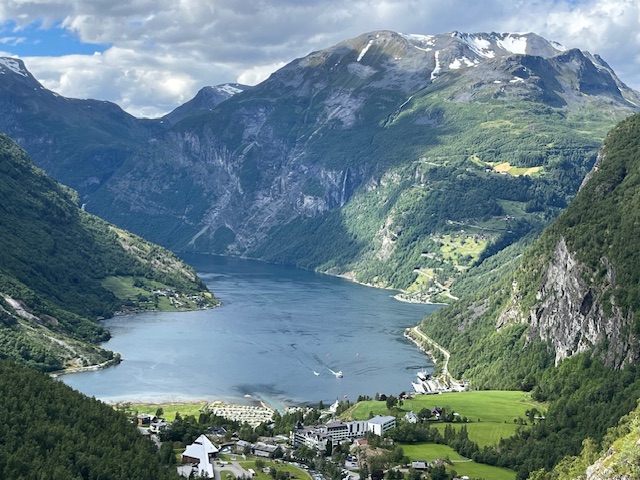

A few years ago, my Norwegian relatives took me on a road trip from the capital, Oslo, through the waterfall-studded mountains to the coastal city of Bergen, a route that many tourists choose to take on their tour of Norway.
Upon returning home, I wanted to see more of Norway, including the Arctic Circle, and Walking Adventures International (WAI) offered a tour that perfectly suited my active personality. Our small group of 24 set off from Bergen and toured along the coast and inland, taking in stunning scenery like the Geirangerfjord and Jotunheimen National Park.


As the name suggests, WAI does walks every day, including some serious hikes in the Norwegian mountains, and has visited historic sites, wooden churches and ice tunnels on Norway’s highest peaks.
Sixteen of us continued on WAI’s extended trip beyond the Arctic Circle, exploring the Vesterålen archipelago and the Norwegian Andoya On the way to Tromsø, we took the Senja Scenic Route, visiting a salmon farm, watching puffins fly around the island of Braeksøya, and learning about the indigenous Sámi culture.
Leaving Bergen, our first walk was along the historic Bryggen waterfront, where in the Middle Ages the Hanseatic League controlled the cod trade primarily. We also explored the bustling waterfront fish market, Gamle (Old) Bergen, and Bergenhus Fortress. Many of us took the Fløyenfunicular (a 6-minute ride) from the city center to the top of Mount Fløyen for some great views.



We then took the local ferry north to Småhamn.Calvogue We headed inland by bus, enjoying impressive scenery each day: towering mountains, cascading waterfalls, and dramatic fjord vistas. A tougher but memorable hike was along part of the historic post road near Geiranger. Originally built in the 1700s to connect Bergen and Trondheim, this section zigzags up one side of the mountain before descending into the Geirangerfjord. Here we hopped on a local ferry for a tour around the UNESCO-listed fjord, marveling at the surrounding mountains and numerous waterfalls.
Norway has a lot of mountains, so there are lots of winding roads and over 900 tunnels that go through the rough terrain. The longest is the 15-mile Laerdal Tunnel, which is also the longest road tunnel in the world.




Norway’s highest peak is Galhöpygen at 8,100 feet in Jotunheimen National Park. There we crossed a boardwalk, crossed the barren permafrost, and entered an ice tunnel at about 6,000 feet above sea level. It covers a total area of almost 4,000 square feet and was carved into 7,000-year-old ice by artist and sculptor Peder Istad. A side tunnel leads to a chamber containing globes and other carvings.
The surrounding permafrost looked barren, but our guide pointed out small plants hiding in the crevices. More than 700 artefacts linked to ancient hunting traditions in the region have emerged from the melting ice; we saw some at the Norwegian Mountain Museum in the nearby village of Lom.

Lom also has a beautifully preserved stave church dating from 1170. Afterwards, we toured the interior of Borgund Stave Church (1180), which was surprisingly small. These stave churches are one of 28 surviving of over 1,000 stave churches built in Norway in the late 12th century. They represent the time when Viking paganism succumbed to Christianity. The detailed carvings reflect both Christian motifs and Viking themes, such as dragons.
Upon arriving in Oslo, we walked from the Royal Palace grounds to the medieval Akers Fortress, passed by the dramatic Opera House (you can walk to the roof for amazing views of the city and harbor). A must-see is Vigeland Sculpture Park, with over 200 sculptures made from granite, bronze and wrought iron – the life’s work of Norway’s most famous sculptor, Gustav Vigeland.



The Fram and Kon-Tiki museums were interesting. The first museum displays polar ships. Fulham There’s also a re-enactment of an early Arctic expedition. The second is the balsa wood raft that Thor Heyerdahl used to cross the Pacific Ocean in 1947 to prove his theory of migration from South America to Polynesia. The Rijksmuseum and Munch Museum each have vast art collections, and both display one of Edvard Munch’s famous paintings, “The Scream” (Munch made several versions of it).
Then 16 of us headed north, beyond the Arctic Circle, to explore Vesterålen. There, we donned survival suits and travelled in a small boat to Vesterålen Aquaculture, learning about salmon farming and how it has evolved since it began in the 1970s. Today, Norway is the world’s largest producer of farmed salmon. Fun fact: Norway introduced salmon sushi to the Japanese in the 1980s.


Another highlight was going on a Zodiac safari out to sea. Break Soya One of Norway’s most famous bird breeding sites, the island is home to over 80,000 pairs of puffins who come to breed between mid-April and early August. White-tailed eagles fly overhead, trying to catch the unsuspecting puffins. Many other seabirds also nest on the island. Break Soya Whales can also be seen on the island.
We walked along the Arctic Ocean Andoya We walked the Senja Scenic Route, two of Norway’s 18 designated routes. Whether we traversed sand, rock or meadow, the scenery was spectacular all around. On our walk from Mefjordvær, we enjoyed the stunning backdrop of rugged mountains.




Our final Arctic destination was Tromsø, one of the best places in the world to view the Northern Lights from September to March, and in June we marveled at the midnight sun while strolling the waterfront of this colorful city.
Tromsø is home to the world’s northernmost university and the Norwegian Arctic University Museum, where we saw an exhibition on the indigenous Sami culture, followed by a traditional Sami woman performance. Joyk Sing our group song.
Another highlight is the Arctic Museum, which documents Tromsø’s role as a gateway to the Arctic for explorers, hunters and researchers from the 17th century to the present day. Tromsø is also home to the Troll Museum…


This “first and only Troll Museum in Norway” introduces the different Norwegian trolls based on their legends and characteristics. For example, Tromso has a relatively benign sea troll, but other trolls can be quite fearsome. Visitors can try out the museum’s augmented reality technology; I did, and placed the face of a Tromso troll on my head.
For more information, visit Walking Adventures International.
 Julie Gangler
Julie Gangler
Julie Gangler visited Japan on Overseas Adventure Travel’s tour “Korea and Japan: Temples, Shrines and Treasures.” She is a freelance writer and works as a media relations consultant for the Snohomish County Tourism Bureau. She began her career as a staff writer for Sunset Magazine and then became the Alaska/Northwest correspondent for Travel Agent Magazine.


